Germination of a plant refers to a phenomenon in which a seed germinates to form a new seeding or plant. The germination process results in the emergence of the radicle (primary root) and plumule (primary shoot). Before germination, the seed remains dormant in the soil.
Then, under favourable conditions (optimum temperature, oxygen, light, water etc.), a seed germinates and promotes embryo development. Thus, an embryo is present within the seed, and the food reserves are stored in the outer layer of the seed or seed coat.
A seed is considered a dormant seed, which lacks an embryo or it does not undergo germination. The germination rate depends upon the growth conditions provided to the seeds to germinate. Germination rate up to 60% indicates that 60 out of 100 seeds will possibly undergo germination at a given period of time.
Germination capacity is another term representing the number of seeds capable of undergoing germination in a given population. This post discusses the definition, process, favourable conditions and factors affecting seed germination.
Content: Germination of Plant
Definition of Germination
Germination refers to the growth phase of the seeds, during which they form a germ tube that further activates the seed’s embryo and promotes the growth of new seedlings. In plants, germination can be categorized into the following two types:
- Epigeal germination: In this kind, a hypocotyl region of the shoot system elongates and goes upward by pulling the cotyledon out of the soil. It mostly occurs in plants like cotton, papaya, onion etc.
- Hypogeal germination: Here, an epicotyl region of the shoot system elongates, and the cotyledon remains inside the soil. It mostly occurs in plants like pea, mango, rice etc.
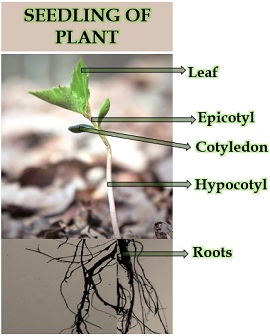
As we could see in the image, epicotyl is the region above the cotyledons, i.e. in the axis of growing seedling. In contrast, the hypocotyl is the region below the cotyledons and above the roots.
Process of Seed Germination
We can summarize the developmental stages during seed germination into the following steps:
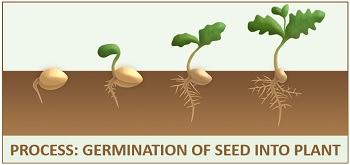
Imbibition
It is the first and the most crucial step for a dormant or dry seed. During the imbibition stage, dry seeds absorb water that results in swelling. After absorbing water, the dry seeds get rehydrated, and the seed coat softens. Further, the swelling ruptures the soft or moistened testa, due to which a radicle comes out of the seed as a “Primary root”.
Respiration
Seeds become metabolically active and respire vigorously in the presence of oxygen. Seeds undergo respiration to fulfil the needs of a growing plant. During this stage, seeds exploit oxygen to convert the nutrients existing in the soil into energy.
Cellular respiration in seeds involves the oxidation of the respiratory substrates to release energy. Proteins, carbohydrates and fats are the usual respiratory substrates of a seed, which on oxidation releases energy (ATP)and carbon dioxide after breaking the C-C bonds.
The Metabolization of Reserve food
The outer aleurone layer of an endosperm produces hydrolysing enzymes via the assistance of gibberellic acid. Hydrolysing enzymes like amylases, proteases etc., helps in the metabolization of reserve food. Seeds assimilate the reserve food materials like stored starch, proteins or fats by harnessing the energy released during cellular respiration.
The hydrolysing enzymes convert the insoluble organic matter into a soluble form and organic food into an elementary form. Then, the simpler food is transported to the growing epicotyl, hypocotyl, radicle, plumule via cotyledons.
Development of the Embryo Axis into Seedling
A seedling grows from an embryo axis after food translocation from the endosperm wall to the different parts. This stage makes the cells of an embryo metabolically active. As a result, the embryo cells undergo rapid cell divisions, expansion and eventually form a seedling.
Factors Affecting
It includes some extrinsic and intrinsic factors.
Extrinsic Factors: Insufficient water supply will neither allow the seed to germinate nor promote radicle and plumule emergence. Germination requires a vigorous oxygen supply, as seeds release energy by consuming oxygen. The energy again dissipates by the seeds for the growth of an embryo. Temperature affects the rate of embryonic growth and the metabolism of food material by the seed.
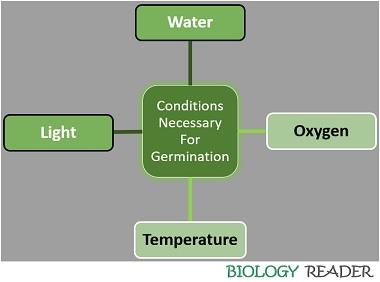
Water
It is a crucial source for seed germination. As already discussed, water is necessary for the seed imbibition to promote the emergence of a radicle and plumule. Excessive water may restrict seed growth.
Due to excessive water, the soil becomes soggy, resulting in insufficient oxygen supply to a plant, causing premature death. Seeds reserve food material like proteins, carbohydrates, fats etc., in a dry state. An embryo within the seed can not utilize the nutrients in dry form.
Thus, the dry organic food material needs to be converted into a liquid form for embryo development or further growth into a seedling. To prove the necessity of water, you can take two beakers. In beaker-A, place dry cotton wool at the bottom and add gram seeds (two or three) over it.
In the beaker-B, place the wet cotton wool and add few gram seeds over it. Allow the seeds to germinate for 1-3 days. After 1-3 days, you could observe that the seeds germinate in the moistened environment, as in the beaker-B.
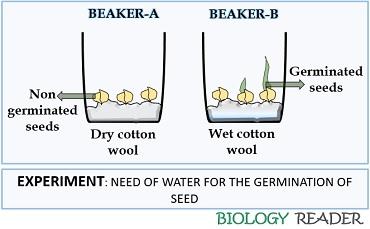
Air
It is also a critical factor necessary for seed growth. To prove the necessity of oxygen in seed germination, you must take two beakers. In beaker-A, boil the water to remove the dissolved oxygen content. Then, cool the water and add few gram seeds to a beaker.
Pour little oil into a beaker, which will prevent the entry of atmospheric oxygen. Lastly, allow the seeds to germinate for several days. Then, in beaker-B, take wet cotton wool, place some gram seeds over it and allow seeds to germinate.
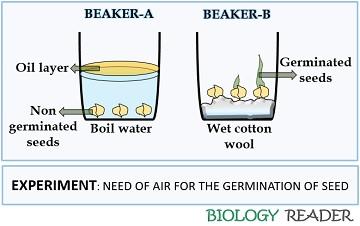
After 2-3 days, you could see the germinated seeds only in beaker-B. The experiment proves that air is necessary for seed germination. Oxygen helps in seed respiration and provides the energy source for the metabolism of complex biomolecules.
Temperature
Seed germination occurs within a temperature range between 0 to 50 degrees Celsius. However, seeds germinate best at a moderate or an optimum temperature within 25 to 30 degrees Celsius.
Very low temperature reduces the seed’s metabolic activity, and a very high temperature destroys the embryonic tissues. Then, take two beakers and label them as ‘A’ and ‘B’ to test the temperature requirement for seed growth.
Add a few gram seeds in beaker-A, and keep it in a box containing some ice cubes. Then, add few gram seeds over the wet cotton wool in beaker B and keep it at room temperature. After 2-3 days, you could observe the germinated seeds in beaker-B placed at room temperature.
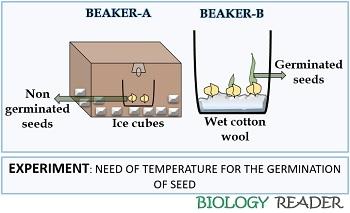
Hence, it is proved that components like water, air and temperature are necessary for seed germination. An experiment named the “Three bean experiment” also demonstrates the necessity of oxygen, water, and temperature for seed germination. This experiment makes the use of 3 bean seeds:
- One grain sets inside the water.
- A second seed sets partially in the water.
- A third seed above the water.
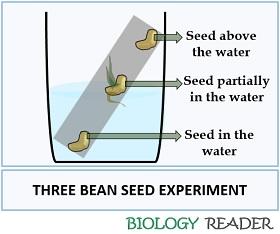
Allow the seeds to germinate and wait up to 2-3 days. This experiment proves that a seed partially dipped in the water will germinate as it gets air, light and water at the same time.
Light and Darkness
In addition to air, water and temperature, the presence or absence of light also plays an important role. Seed germination occurs in the darkness within the soil that primarily forms a primary root.
But, seeds require light during a shoot development, under which it gets energy from the process of photosynthesis. A shoot undergoes “Photomorphogenesis”, during which a seedling grows, forms leaf and turns green under the presence of sunlight.
Intrinsic Factors: Seed dormancy is a condition during which the seeds do not germinate and remain in a dormant state by a restricted growth of an embryo, restricted water and oxygen supply. Seed germination is also affected by the plant hormones like abscisic acid (ABA) that inhibits the germination process.
Awesome information